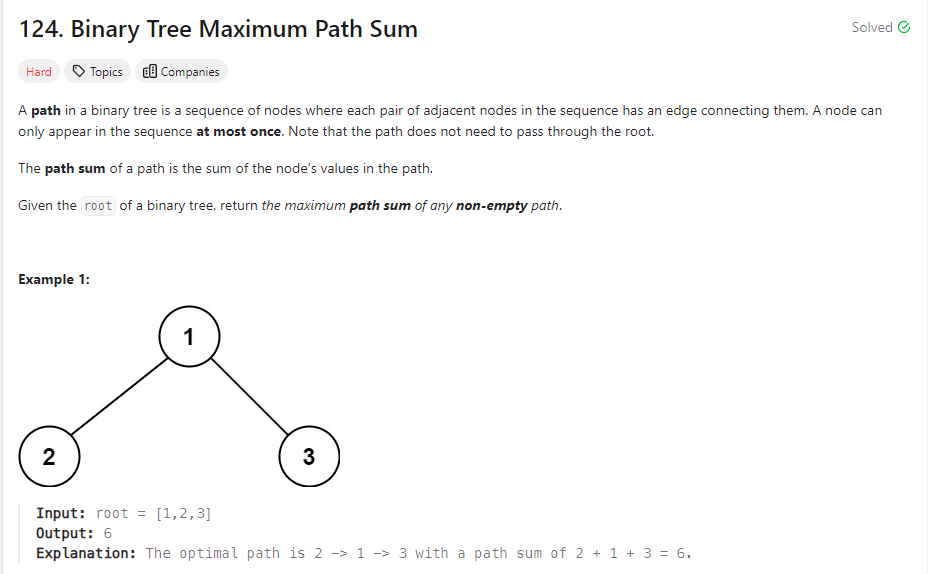Problem of The Day: Binary Tree Maximum Path Sum
Problem Statement
See Link.
Intuition
The problem involves finding the maximum path sum in a binary tree. The idea is to traverse the tree in a depth-first manner while keeping track of the maximum path sum encountered so far.
Approach
In order to tackle the problem of finding the maximum path sum in a binary tree, I employ a recursive depth-first search (DFS) approach. The basic idea of the solution lies in a helper function named dfs, which takes a node as its input. Within this function, I address the base case where the node is None, returning negative infinity to signify that there is no contribution from this non-existent node. Subsequently, I recursively compute the maximum path sum for both the left and right subtrees. To maximize the path sum, I handle scenarios where the contributions from the left and right subtrees are negative by treating them as zero. I then calculate the maximum path sum, considering the current node, and update the global maximum if necessary. The dfs function returns the maximum path sum that can be extended from the current node to its parent. The main function, maxPathSum, initializes a global result variable and invokes the dfs function on the root of the binary tree. The final maximum path sum is then returned by the main function.
Complexity
-
Time complexity: O(n) - The algorithm traverses each node of the binary tree once.
-
Space complexity: O(h) - The recursion stack space is proportional to the height of the binary tree, where h is the height. In the worst case, when the tree is skewed, the space complexity is O(n).
Code
# Definition for a binary tree node.
# class TreeNode:
# def __init__(self, val=0, left=None, right=None):
# self.val = val
# self.left = left
# self.right = right
class Solution:
def maxPathSum(self, root: Optional[TreeNode]) -> int:
def dfs(node):
if not node:
return float('-inf')
left = dfs(node.left)
right = dfs(node.right)
left = 0 if left < 0 else left
right = 0 if right < 0 else right
include_node = left + right + node.val
dfs.result = max(dfs.result, include_node)
return max(left + node.val, right + node.val)
if not root:
return 0
dfs.result = float('-inf')
dfs(root)
return dfs.result
Editorial Solution
class Solution:
def max_path_sum(self, root: Optional[TreeNode]) -> int:
max_path = -float('inf')
# post order traversal of subtree rooted at `node`
def gain_from_subtree(node: Optional[TreeNode]) -> int:
nonlocal max_path
if not node:
return 0
# add the gain from the left subtree. Note that if the
# gain is negative, we can ignore it, or count it as 0.
# This is the reason we use `max` here.
gain_from_left = max(gain_from_subtree(node.left), 0)
# add the gain / path sum from right subtree. 0 if negative
gain_from_right = max(gain_from_subtree(node.right), 0)
# if left or right gain are negative, they are counted
# as 0, so this statement takes care of all four scenarios
max_path = max(max_path, gain_from_left + gain_from_right + node.val)
# return the max sum for a path starting at the root of subtree
return max(
gain_from_left + node.val,
gain_from_right + node.val
)
gain_from_subtree(root)
return max_path
